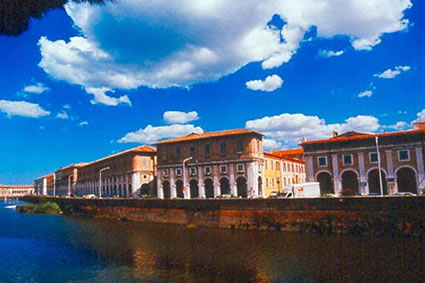Chapter One: Reign of the Senones
Part Three: The Foundations of Sena
Located on the Adriatic, the town the Senones settled, which would later become a city to be known as Sena [1] had humble beginnings. Originally the war encampment of Brennos’ Senone horde on the mouth of the River Misa, it would later become a major political center of Italia in later decades.
When Brennos returned from his war with the Romans, he came back to Sena with all the riches of the burnt city. The women of the city were taken by the Celtic soldiers and distributed as wives or servants. It is estimated that after the burning of Roma, and the consequent rape of Roman women, the Senone population boomed into the next generation. Roman workers and slaves had two options: enslavement under the Senones, or sacrifice to the Celtic gods. Most chose slavery, and carried much of the rubble of Roma across the Apennines to Sena to help build the city.
While Brennos by no means had any plans of a grand city, he was pragmatic. From the stones of Roman buildings, a defensive wall was built around Sena. Like many Celtic cities of the period, Sena was shaped in a fort-like foundation with the wealthiest parts of the city found at the center. But the city certainly had an Italian flair with stone walls, and houses, though of Celtic architecture, built from materials used in Italian houses.
In 378 B.E. (385 B.C.) Brennos officially declared himself the King of the Sena. Though the decision would seem obvious, several Senone nobles challenged Brennos for the right to the throne. Two prominent contenders included the chieftains Catugaesum and Tarvos [2]. Rallying their men, the three chieftains quickly resorted to violence to validate their claim to the throne.
Catugaesum’s faction met Brennos in battle that summer outside Sena. The two forces, relatively small compared to the force sent to sack Clevsin and Roma, probably comprised of one thousand men on each side.
Catugaesum stood out in front of his army dressed in full Celtic noble armor. His long mustache flowed in the wind as he shouted insults at Brennos, called him a coward, the son of a swine and a whore, and insulted his masculinity. Brennos responded by shouting back that Catugaesum was the coward, not he, and that Catugaesum could not pleasure a woman without having the shaft of a spear to assist him in penetrating [3]. Both sides beat their shields and blew their war-horns like wolves howling in the wind.
Battle quickly ensued. In the fray, Brennos met Catugaesum and the two fought. In the end, Brennos came out victorious, hewing Catagaesum in half with his sword. As was tradition, Brennos claimed his enemy’s head and hung it from around the neck of his horse.
While Catugaesum’s doom is well documented, little is known about the fate of Brennos’ other rival for the throne, Tarvos. Sources are contradictory, as some claim that Brennos defeated him in a duel before both of their armies, while other sources claim that Tarvos surrendered his claim to the throne in exchange for gold and land.
Regardless, it is certain that by the end of 377 B.E. (384 B.C.) the Senone chieftain Brennos claimed the title of Senonirix [4], King of Sena.
-----------
[1] Likely derived from the tribal name Senone by other Italic tribes
[2] Names mean “Battle-Spear” and “Bull” respectively. I must admit that both of these men are fictional, because so little is known about the Senones of this period.
[3] Not exactly classy or heroic, but the Celts definitely knew how to make someone feel like shit before killing them.
[4] Literally means king of the Senones. At this period, the name the Senones gave their city is unknown. The city would only later be known as Sena.

